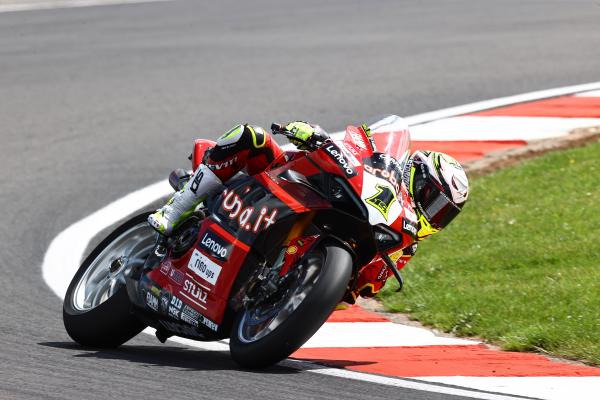
We have seen in the past season-and-a-half of WorldSBK that one of Ducati’s strengths, especially in the hands of Alvaro Bautista, is conserving the rear tyre.
On Friday, Jonathan Rea told the media that WorldSBK sole tyre supplier Pirelli had informed him that the rear tyre is consumed more with Donignton’s new surface than it is at other circuits. It seemed that this could lend itself to Kawasaki’s advantage, as their major problem this year has been front tyre consumption.
But, instead, it played to the advantage of Bautista and Ducati, because it meant they could exploit one of their greatest strengths even in a circuit that did not suit their bike, which, historically, Donington has not.
While Bautista’s riding style and ability should not be discounted, a part of Ducati’s ability to save the rear tyre is its ability to provide rear grip. This was proven by Danilo Petrucci, who found speed in the end of Race 1 compared to Jonathan Rea, but ultimately failed in his podium quest on Saturday due to lingering physical issues from his crash in Misano. On Sunday, in Race 2, Petrucci fixed the latter part, but via a similar method: a second-half charge through the pack to finish third.
But, Ducati’s rear tyre management was also proven by the acceleration of the Ducati, especially from the long corners, where the riders are using the throttle to finish the corner, and where Bautista would make ground on his rivals. From the TV, it was a visual difference from the on-board camera of Jonathan Rea when Bautista made his move to the lead over Yamaha's Toprak Razgatlioglu in Saturday’s opening race of the weekend.
It was this drive grip and acceleration that Razgatlioglu attributed to Bautista’s advantage after Race 1 on Saturday. “The beginning was good, I was enjoying it,” Razgatlioglu said. “But, after, Alvaro [Bautista] had a good pace, and I tried to catch him. But it was impossible, because in all the short straights, he had unbelievable acceleration, because his electronics were working well, and the power of his bike is unbelievable.
“I am very strong in turn 11, but, after the chicane, when he shifted gear, his bike had unbelievable acceleration, so it was not possible for me to pass him again, because the gap is not normal.”
Jonathan Rea put this acceleration down to the whole Ducati package, although, from his comments, it can be deduced that the way Panigale V4 R uses the rear tyre - both to generate grip and to manage it over the course of the race - is seen as its advantage.
“It was impossible,” Rea said. “When [Bautista] passed Toprak [Razgatlioglu], Toprak was lining him up again on the exit [of Coppice, to pass into the chicane]. When I saw [Bautista’s] grip on the right-hand side of the tyre, and his acceleration, I thought ‘Toprak’s Toprak, he’s going to pass him in the chicane,’ and then when I [was] halfway down the straight I thought ‘he’s miles away, he’s never going to try.'
“So, how can you manage like that? It’s impossible.
“The funny thing was [Bautista was] not consuming the rear tyre, [he] just had so much rear traction. So, yeah, [Bautista’s] doing incredible.”
Perhaps Bautista recognised this, too. During Race 2, while Razgatlioglu was leading in the first part of the race, he was lapping in the mid-1:26s. However, when Bautista hit the front, both he and Razgatlioglu were running in the low-1:26s. This was not a surprise, Bautista said, because of Razgatlioglu's pace in the Superpole Race using the same tyre compound (SC0) as in Race 2.
“In the [Superpole Race], he [Razgatlioglu] did a lot of low-1:26s," Bautista said, "so I knew that he can follow me for some laps. But I knew also that, if I can keep that pace until the end, for him, for sure, it was more difficult [to keep the pace], because in some areas he was stronger than me, but in other areas I can be faster [than Razgatlioglu]. So, I knew that, if I was concentrated and focused and tried to keep that pace, he can maybe do three or four laps behind me, but tenth-by-tenth he was losing, and, in the end, [that] was what happened.”
If Razgatlioglu was able to keep the pace of Bautista after he hit the front for just a few laps, that was not the case for Jonathan Rea, or his Kawasaki teammate, Alex Lowes.
Lowes offered an explanation for the Kawasaki’s additional tyre consumption compared to its rivals. The issue, Lowes said, is both complex and fundamental to the current ZX-10RR in combination with the recent progress from Pirelli.
“I think, for Kawasaki, they’ve been so dominant here over the years, but you can’t look back at that, it’s a different game now - the guys are doing 1:26s every lap; I did a 1:27.0 on lap 20 [but, with that pace] you go backwards. I know there’s a new surface [at Donington], but the pace is incredible.
“It looks like our bike- it’s been the same for a long time, especially from the chassis point of view, and I think that the tyres have changed a lot, over the last three or four years, especially. The way the tyres work, it’s a [much] softer [tread] rubber now, the construction has changed, and Pirelli have done a fantastic job.
“But,” Lowes continued, “it looks like, with the stiffer construction of the tyres, with the softer [tread] rubber, we work it too much.”
This was something that had a particular effect on both Kawasaki riders in Race 2. Lowes struggled particularly in the second half of the race, but Rea struggled from the beginning.
“The general characteristic of the weekend was the same,” Lowes said. “We were quite fast, but, when the tyre drops, we really struggle to keep our pace - Johnny [Rea] manages better, obviously, but it’s a similar characteristic for him: he was fighting for the win in the first two races, especially the Superpole Race, but he just runs out of grip.
“I feel like we have more grip at the start, [other riders] hang in there, and then, at the end of the race, we drop, and people have a bit more grip than us - that’s the characteristic that keeps occurring.”
For Jonathan Rea, though, the issue was there from the start. “I struggled from the beginning with the rear tyre traction,” Rea said after Race 2. “I could see quite early that I was struggling on the edge of the tyre. Then, from mid-distance, when Alvaro [Bautista] came past at the chicane, I struggled so bad everywhere on the edge of the tyre, even the left side, which we don’t use too much [at Donington]. Going up through [Starkey’s and] Schwantz, the bike was just like it had so much pressure in the rear, or so much preload, it was just sitting and spinning. Then it was really hard because the bike became physical and it was moving a lot.
“We need to analyse a bit further what happened there because all weekend I’ve felt better than in that race; that race was the probably the worst one of the weekend.”
It seems that the Ducati’s strength combines with the Kawasaki’s weakness to create a kind of ‘perfect storm’ for the Akashi marque’s riders when fighting with the bikes from Bologna. The Ducati is able to extract a lot of grip from the rear tyre over a long duration of time - approximately the distance of a WorldSBK race - whereas the Kawasaki struggles to find grip from the tyres even when they are new, if the conditions are not suitable for the ZX-10RR, and the issue progresses negatively as the tyre wears.
Yet, Rea was fast in the 10-lap Superpole Race, indicating that the Kawasaki perhaps suffers from a narrow operating window; meaning, the ZX-10RR can work well with the tyres, but requires the right conditions to do so. These conditions were present in the Superpole Race, when Rea felt he could have won, but not in Race 2, when he finished fifth.
The #65 said he had made some changes to the bike for Race 2, but nothing that he felt should have affected his feeling compared to the rest of the weekend so dramatically. “We didn’t make too many changes, to be honest. A little bit of ride height in the front, but nothing that would put us that far out of the [operating] window.”
The next round is Imola. “It’s going to be hot,” Rea said. Additionally, the Imola layout stresses both the front and rear tyres significantly, due to the several hard braking zones entering the several chicanes (Tamburello, Villeneuve, Alta, Bassa, as well as le due Rivazze) and the hard accelerations which follow them.
Nonetheless, Rea found reason for optimism, for the third factor of chicanes, between the deceleration and acceleration: that being changing direction. “Our bike changes direction quite well in the chicanes,” Rea said. “This weekend [in Donington], the chicane was quite good for me. Imola has a lot [of chicanes].”

